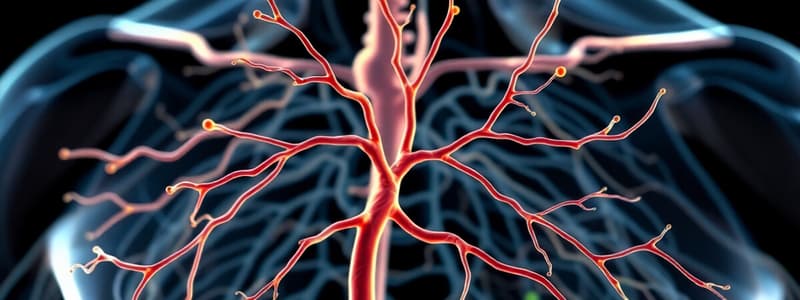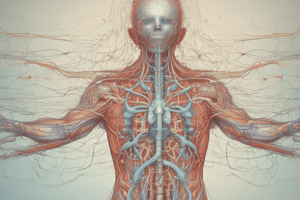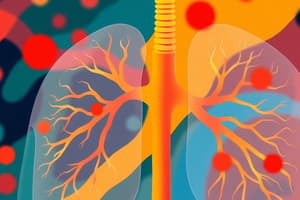Podcast
Questions and Answers
Which component is NOT part of the nervous system as described?
Which component is NOT part of the nervous system as described?
- Sensory organs
- Spinal cord
- Lungs (correct)
- Brain
What are the three basic functions of the nervous system when responding to environmental changes?
What are the three basic functions of the nervous system when responding to environmental changes?
- Recognize, Process, Integrate (correct)
- Perceive, Respond, Maintain
- Observe, Adapt, Execute
- Recognize, Analyze, React
Which system is targeted by drugs developed for autonomic pharmacology?
Which system is targeted by drugs developed for autonomic pharmacology?
- Central nervous system only
- Voluntary nervous system only
- Peripheral vascular system only
- Autonomic nervous system (correct)
What does the nervous system do when it recognizes environmental changes?
What does the nervous system do when it recognizes environmental changes?
What is the primary effect of muscarinic antagonists when administered to patients with respiratory disorders?
What is the primary effect of muscarinic antagonists when administered to patients with respiratory disorders?
In which urinary disorder might muscarinic antagonists be particularly beneficial?
In which urinary disorder might muscarinic antagonists be particularly beneficial?
How do muscarinic antagonists affect gastrointestinal disorders?
How do muscarinic antagonists affect gastrointestinal disorders?
What neurotransmitter is primarily involved in the 'rest-and-digest' response of the parasympathetic nervous system?
What neurotransmitter is primarily involved in the 'rest-and-digest' response of the parasympathetic nervous system?
What is the role of acetylcholinesterase in relation to acetylcholine in the nervous system?
What is the role of acetylcholinesterase in relation to acetylcholine in the nervous system?
What can result from cholinergic poisoning due to excessive acetylcholine?
What can result from cholinergic poisoning due to excessive acetylcholine?
What condition would NOT generally be treated with muscarinic antagonists?
What condition would NOT generally be treated with muscarinic antagonists?
Which of the following statements about Sarin gas is accurate?
Which of the following statements about Sarin gas is accurate?
Which of the following receptors is primarily found in the heart?
Which of the following receptors is primarily found in the heart?
Which receptor is associated with relaxing uterine smooth muscle?
Which receptor is associated with relaxing uterine smooth muscle?
What is the effect of activating β1 receptors in the body?
What is the effect of activating β1 receptors in the body?
Which receptor is primarily responsible for decreasing the release of norepinephrine from the presynaptic neuron?
Which receptor is primarily responsible for decreasing the release of norepinephrine from the presynaptic neuron?
The contraction of smooth muscle in the vasculature is primarily mediated by which receptor?
The contraction of smooth muscle in the vasculature is primarily mediated by which receptor?
Which of the following organs is primarily affected by β2 receptor activation?
Which of the following organs is primarily affected by β2 receptor activation?
What physiological response occurs when β2 receptors are activated?
What physiological response occurs when β2 receptors are activated?
Which receptors are involved in the postsynaptic action of norepinephrine?
Which receptors are involved in the postsynaptic action of norepinephrine?
What is an example of a non-depolarizing neuromuscular blocker?
What is an example of a non-depolarizing neuromuscular blocker?
During which phase does desensitization occur in depolarizing neuromuscular blockers?
During which phase does desensitization occur in depolarizing neuromuscular blockers?
What is a common adverse effect of depolarizing neuromuscular blockade?
What is a common adverse effect of depolarizing neuromuscular blockade?
What is the primary clinical indication for neuromuscular blockers?
What is the primary clinical indication for neuromuscular blockers?
Which of the following is a type of anesthetic NOT typically used in balanced anesthesia?
Which of the following is a type of anesthetic NOT typically used in balanced anesthesia?
What is one of the mechanisms that lead to drug tolerance?
What is one of the mechanisms that lead to drug tolerance?
Which characteristic is commonly associated with addictive drugs?
Which characteristic is commonly associated with addictive drugs?
What does drug withdrawal refer to?
What does drug withdrawal refer to?
Which of the following best describes substance use disorder (SUD)?
Which of the following best describes substance use disorder (SUD)?
What is cross tolerance?
What is cross tolerance?
What is a common clinical application for local anesthesia?
What is a common clinical application for local anesthesia?
What effect does sustained exposure to a drug typically have?
What effect does sustained exposure to a drug typically have?
What is the onset time of succinylcholine?
What is the onset time of succinylcholine?
Which of these is NOT a factor influencing substance use disorder (SUD)?
Which of these is NOT a factor influencing substance use disorder (SUD)?
What is the primary goal of general anesthesia?
What is the primary goal of general anesthesia?
What accounts for the short duration of action of succinylcholine?
What accounts for the short duration of action of succinylcholine?
What is the primary result of the desensitizing phase when using succinylcholine?
What is the primary result of the desensitizing phase when using succinylcholine?
What occurs during the depolarizing phase of succinylcholine's action?
What occurs during the depolarizing phase of succinylcholine's action?
How long does full depolarizing neuromuscular block by succinylcholine typically take to achieve?
How long does full depolarizing neuromuscular block by succinylcholine typically take to achieve?
Which of the following statements about the action of succinylcholine is true?
Which of the following statements about the action of succinylcholine is true?
What happens to muscle fibers after prolonged exposure to succinylcholine?
What happens to muscle fibers after prolonged exposure to succinylcholine?
Which of the following is NOT a characteristic of succinylcholine compared to non-depolarizing blockers?
Which of the following is NOT a characteristic of succinylcholine compared to non-depolarizing blockers?
Which statement correctly describes a function of the sympathetic nervous system?
Which statement correctly describes a function of the sympathetic nervous system?
How many neurons are required by the somatic nervous system to reach its target organ?
How many neurons are required by the somatic nervous system to reach its target organ?
What role do neuromuscular blocking drugs play during surgical procedures?
What role do neuromuscular blocking drugs play during surgical procedures?
Which statement about the autonomic and somatic nervous systems is correct?
Which statement about the autonomic and somatic nervous systems is correct?
What is a key difference between the sympathetic and parasympathetic nervous systems?
What is a key difference between the sympathetic and parasympathetic nervous systems?
Which receptors are primarily involved in the sympathetic nervous system’s action on the heart?
Which receptors are primarily involved in the sympathetic nervous system’s action on the heart?
What is the major purpose of anesthetics during surgical procedures?
What is the major purpose of anesthetics during surgical procedures?
In the context of the somatic nervous system, what type of muscle does it primarily innervate?
In the context of the somatic nervous system, what type of muscle does it primarily innervate?
Flashcards
Non-Depolarizing Neuromuscular Blockers
Non-Depolarizing Neuromuscular Blockers
Neuromuscular blockers that prevent acetylcholine from binding to its receptors, resulting in muscle paralysis.
Tubocurarine
Tubocurarine
A drug that competitively binds to acetylcholine receptors, preventing acetylcholine from activating them, leading to muscle relaxation.
Nervous System
Nervous System
The nervous system, a complex network within the body, acts as the control and communication center.
Recognizes changes in environment
Recognizes changes in environment
Signup and view all the flashcards
Processes and Integrates
Processes and Integrates
Signup and view all the flashcards
Responds to changes
Responds to changes
Signup and view all the flashcards
Three functions of the nervous system
Three functions of the nervous system
Signup and view all the flashcards
What are neuropharmaceuticals?
What are neuropharmaceuticals?
Signup and view all the flashcards
What is Neurotransmission?
What is Neurotransmission?
Signup and view all the flashcards
Components of the nervous system
Components of the nervous system
Signup and view all the flashcards
What's the structure of the sympathetic nervous system?
What's the structure of the sympathetic nervous system?
Signup and view all the flashcards
Where are β1 receptors located?
Where are β1 receptors located?
Signup and view all the flashcards
What does the somatic nervous system control?
What does the somatic nervous system control?
Signup and view all the flashcards
How many neurons does the somatic nervous system use?
How many neurons does the somatic nervous system use?
Signup and view all the flashcards
What are neuromuscular blocking drugs used for?
What are neuromuscular blocking drugs used for?
Signup and view all the flashcards
What benefits did neuromuscular blocking drugs and anesthetics bring to surgery?
What benefits did neuromuscular blocking drugs and anesthetics bring to surgery?
Signup and view all the flashcards
Where does the somatic nervous system belong?
Where does the somatic nervous system belong?
Signup and view all the flashcards
What's the difference between the autonomic and somatic nervous systems?
What's the difference between the autonomic and somatic nervous systems?
Signup and view all the flashcards
What are muscarinic antagonists?
What are muscarinic antagonists?
Signup and view all the flashcards
How are muscarinic antagonists used in respiratory disorders?
How are muscarinic antagonists used in respiratory disorders?
Signup and view all the flashcards
How are muscarinic antagonists used in urinary disorders?
How are muscarinic antagonists used in urinary disorders?
Signup and view all the flashcards
How are muscarinic antagonists used in GI disorders?
How are muscarinic antagonists used in GI disorders?
Signup and view all the flashcards
What is acetylcholine's role in the parasympathetic nervous system?
What is acetylcholine's role in the parasympathetic nervous system?
Signup and view all the flashcards
What is acetylcholinesterase?
What is acetylcholinesterase?
Signup and view all the flashcards
How does Sarin work?
How does Sarin work?
Signup and view all the flashcards
What is cholinergic poisoning?
What is cholinergic poisoning?
Signup and view all the flashcards
What are the primary locations and actions of β1 receptors?
What are the primary locations and actions of β1 receptors?
Signup and view all the flashcards
Where are β2 receptors located and what is their primary action?
Where are β2 receptors located and what is their primary action?
Signup and view all the flashcards
What are the location and function of α2 receptors?
What are the location and function of α2 receptors?
Signup and view all the flashcards
What are the locations and effects of α1 receptors?
What are the locations and effects of α1 receptors?
Signup and view all the flashcards
What is norepinephrine and how does it act on target organs?
What is norepinephrine and how does it act on target organs?
Signup and view all the flashcards
What is the sympathetic nervous system and its purpose?
What is the sympathetic nervous system and its purpose?
Signup and view all the flashcards
What is the autonomic nervous system?
What is the autonomic nervous system?
Signup and view all the flashcards
What is the parasympathetic nervous system and its role?
What is the parasympathetic nervous system and its role?
Signup and view all the flashcards
How does succinylcholine work?
How does succinylcholine work?
Signup and view all the flashcards
What is succinylcholine's onset of action?
What is succinylcholine's onset of action?
Signup and view all the flashcards
Why is succinylcholine's effect short?
Why is succinylcholine's effect short?
Signup and view all the flashcards
What are fasciculations?
What are fasciculations?
Signup and view all the flashcards
What happens in the depolarizing phase?
What happens in the depolarizing phase?
Signup and view all the flashcards
Explain the desensitizing phase.
Explain the desensitizing phase.
Signup and view all the flashcards
How long does it take for succinylcholine to fully paralyze muscles?
How long does it take for succinylcholine to fully paralyze muscles?
Signup and view all the flashcards
What are the two phases of action for depolarizing blocking agents?
What are the two phases of action for depolarizing blocking agents?
Signup and view all the flashcards
Study Notes
Module 02: Introduction to the Nervous System
- This module is designed for interaction with online learning resources.
- The Module Companion Guide complements the online slides.
- Discrepancies between the guide and the module should be resolved by referencing the module.
- Do not share the Module Companion Guide with students not enrolled in the course.
- Sharing the guide violates the Academic Integrity Policy of Queen's University.
- Students violating the policy face sanctions.
Table of Contents
- Learning outcomes, icons, and assignments listed for each module section.
- Specific topics include neurotransmission, autonomic pharmacology, parasympathetic and sympathetic nervous systems and neuromuscular disorders, which are all components of the nervous system.
- Questions are included throughout each section for self-assessment.
- Sections on neurotransmission, organization of the nervous system (CNS and PNS) and review of the nervous system are all introduced.
- The module includes information for the parasympathetic nervous system, including its neurons, organization, neurotransmitters, receptors, and other associated topics.
- The module also deals with sympathetic nervous system topics such as neurons, organization, and other associated topics like neurotransmitters, and receptors.
- Neuromuscular blocking drugs and their related clinical uses are also discussed in this module.
- The module concludes with an introduction to substance use disorders (SUD), exploring social impairments and risky use aspects, as well as withdrawal and tolerance.
- Additional topics like glaucoma, poor muscle tone in the bladder, and asthma are also incorporated across sections
- A summary is provided at the end of the module.
Introduction
- The nervous system is the body's control and communication system, encompassing the brain, spinal cord, and nerves for voluntary and involuntary actions.
- The nervous system needs to be targeted by many drugs.
- The nervous system has three basic steps in responding to the environment: recognize, process, and react.
- Recognition involves acknowledging changes in internal and external surroundings.
- Processing involves interpreting these environmental changes.
- Reaction involves responding to the changes through appropriate actions.
Neuronal Communication and Neurotransmission
- Neurotransmission is the primary mode of communication between neurons.
- It is a chemical process where neurotransmitters facilitate the transmission of signals from one neuron to another.
- Removal of neurotransmitters is crucial to terminate the signal.
- Transporters in presynaptic neurons are the mechanism by which neurotransmitters clear the synaptic cleft.
Organization of the Nervous System
- The nervous system is generally divided into two major components: central nervous system (CNS) and peripheral nervous system (PNS).
- The CNS comprises the brain and spinal cord.
- The PNS encompasses all nerve fibers outside the CNS.
Autonomic Nervous System (ANS)
- This system controls involuntary actions like heart rate, blood pressure, and digestion.
- It functions as a two-neuron system.
- It's divided into parasympathetic ("rest-and-digest") and sympathetic ("fight-or-flight") to achieve balance and control bodily functions.
Substance Use Disorders (SUD)
- Criteria for diagnosing SUD involve aspects like social impairment, risky use, impaired control, withdrawal, and tolerance to substances.
Studying That Suits You
Use AI to generate personalized quizzes and flashcards to suit your learning preferences.
Related Documents
Description
Test your understanding of the nervous system and its functions with this quiz. Explore key concepts such as the Virtual Ileum Lab, the basic functions of the nervous system, and the effects of drugs in autonomic pharmacology. Perfect for students looking to solidify their knowledge in this area.




